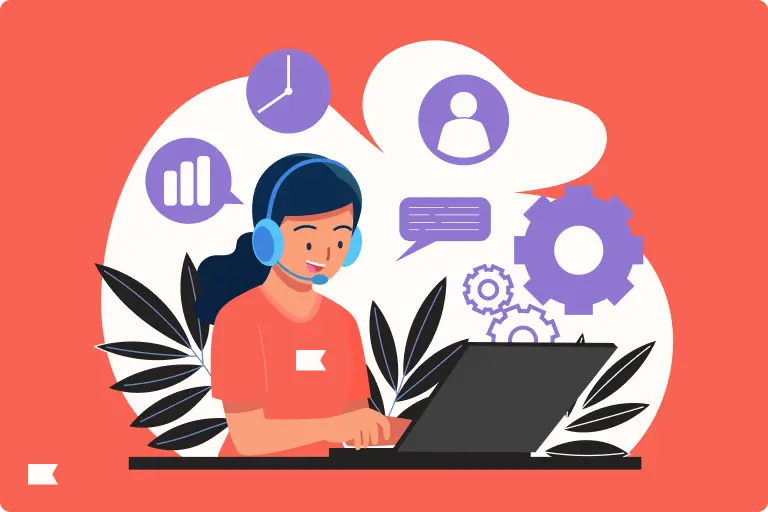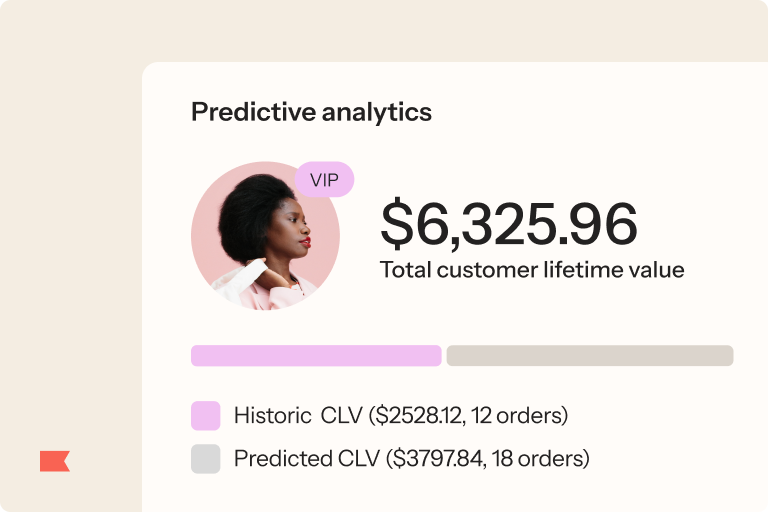5 ways to build loyalty through omnichannel post-purchase experiences

As a business owner or marketer, there’s no better feeling than bringing in a new customer.
Brands spend a lot of money on customer acquisition. According to Klaviyo’s 2025 state of B2C marketing report, 73% of B2C marketers say customer acquisition is getting more expensive—but only 14% say they’re prioritizing retention.
This investment gap presents an opportunity for your brand. Too often, the moment of purchase signals the end of the customer relationship. In reality, it’s just the beginning.
The post-purchase customer experience is made up of every interaction someone has with your brand after they buy. It includes transactional messages, follow-up promotions, customer support, and re-engagement flows.
This experience can determine whether customers decide to buy again, recommend your brand to others, or even let people know to steer clear.
A great post-purchase experience is personalized, transparent, and accessible across multiple channels. To stand out, your post-purchase experience should strike a balance between helpful and promotional.
Let’s explore 5 ways businesses can improve the post-purchase experience, increase lifetime value (LTV), and turn one-time buyers into loyal customers.
1. Build trust immediately after purchase
Klaviyo’s 2025 future of consumer marketing report found that 1 in 5 consumers stop buying from brands after a single negative experience. That’s a lot of potential revenue loss, considering industry benchmarks from Gorgias show that repeat customers generate 300% more revenue than first-time customers.
The immediate moments after a purchase count for a lot. Customers are wondering if their purchase will arrive on time, fit their needs, or generally live up to their expectations.
The more you can reassure someone about their decision to buy, the better the impression you make. And that can eventually lead to another purchase.
Here are a few ways to start the post-purchase experience strong:
- Provide a self-service option. Offer customers access to real-time order updates in an on-site customer hub. Self-service gives customers a sense of control while also reducing support tickets for a common inquiry.
- Send order updates early and often. Set up automated flows that go out when an order is processed, shipped, on the way, and delivered. To improve post-purchase communication, use CRM integrations to pull in data from your shipping and delivery platform, returns management platform, and other relevant post-purchase tools.
- Be available. Make it clear to customers how they can reach your support team, whether that’s in your post-purchase messages, on your website, or in your customer hub. Offer instant support across web chat, text message, email, and WhatsApp with both AI and human agents.
Jewelry brand Caitlyn Minimalist sends a lot of personalized orders to customers, which take up to two weeks to fabricate. During that time, customers used to reach out frequently to the customer service team for status updates.
Now, the brand now uses a centralized CRM to automate transactional emails that contain clear production timelines—a change which has resulted in a drop in customer service outreach about orders in progress.
2. Serve customers across multiple channels
Klaviyo’s 2025 BFCM forecast found that 77% of omnichannel consumers use 3–4 channels, and 23% use 5 or more. Gartner research, meanwhile, shows that seamless transitions between channels are one of the main elements of a positive customer experience: 93% of customers have high customer satisfaction scores when they have seamless handoffs.
Here are a few ways to create omnichannel post-purchase experiences that feel smooth on the customer’s end:
- Align marketing and support teams with a unified tech stack. Connect marketing and service teams with consolidated customer data through an all-in-one all-in-one CRM. These teams should be drawing from the same real-time data across multiple channels. That’s the backbone of a memorable post-purchase experience.
- Offer customer support across multiple channels. Make it easy for customers to reach out via email, web chat, text, WhatsApp, and social media. To improve flow on your end, aggregate every conversation in a shared AI-powered helpdesk.
- Build post-purchase journeys that span channels, too. Maybe one customer prefers to get product education via email, but another prefers a quick link to a YouTube video via text. Use an omnichannel marketing automation platform to coordinate your post-purchase messages across all brand channels as a way to reduce message fatigue.
3. Use transactional messages to strengthen relationships
Transactional messages may be logistical in nature, but they’re also a great opportunity to set expectations and build customer relationships. According to Klaviyo’s latest marketing benchmarks, post-purchase flows see an average open rate of 60%.
Given that the average flow only drives 49% open rates, brands have a big opportunity with post-purchase messages to reach customers when they’re highly engaged.
Important note: Provided you’re following local regulations for what transactional messages need to look like in each region, you may have an opportunity to include a bit more than order information.
Here are a few ways to elevate transactional post-purchase moments:
- Share social proof. Highlight stories from happy customers, like user-generated content (UGC), testimonials, and reviews. Social proof can reassure customers they made the right decision to purchase and even encourage them to submit their own review.
- Ask for referral requests. Turn happy customers into brand advocates with suggested social media copy and referral program incentives. Make sure to time these requests based on product usage, so you don’t send them too early.
- Turn packaging into a touchpoint. Unboxing is the only post-purchase interaction with a 100% “open rate.” Use a QR code to make it easy for customers to share their experience with your brand or access a discount on a next purchase.
- Send educational content. Help people get the most from their purchase with care instructions, product guides, and other resources.
- Invite subscribers to join loyalty programs. Include details like perks and rewards, with information about how much they’ve already earned from their recent purchase.
4. Reduce friction with self-service and transparency
According to Microsoft research, over 90% of consumers expect self-service support options. But Gartner reports that only 14% of issues are fully resolved this way.
There’s an opportunity here for brands to reduce friction during the post-purchase experience and stand out with intuitive customer portals and always-on AI customer agents.
Investing in self-service order tracking—and making the return process transparent and simple—can improve the customer experience and reduce the need for human support.
Officewear brand Ministry of Supply, for example, wanted to create a more personalized, on-brand customer account experience that was more than a static order page. The brand invested in a customer portal that plugs directly into their ecommerce store and allows customers to:
- Track order updates and purchase history.
- See recently viewed items with links to product pages for easy repurchasing.
- Get personalized product recommendations.
Since launching the portal, the brand has seen 12,000 self-serve support interactions and a decrease in email support tickets per customer.
Caitlyn Minimalist also gives customers access to a personalized, self-service customer hub where they can log in and check orders, see their rewards, contact support, and more. Since launch, the brand has seen a 90% YoY drop in traffic to their static Shopify Accounts page, which means fewer customers are leaving the shopping journey to check their order status. They’re managing everything in the hub instead.
5. Use customer data and AI to personalize the post-purchase experience
According to Klaviyo’s future of consumer marketing report, 74% of consumers expect personalized experiences from brands. Customer data is how you can deliver on that expectation, and post-purchase experiences are an ideal site for collecting and using that data.
With every post-purchase interaction, you have the chance to learn more about every customer. You can gather data about their preferences, get product feedback, and watch for signals that they may churn.
Get to know your customers and personalize post-purchase communications by:
- Segmenting based on spend: Send exclusive VIP retention offers to customers with high average order values (AOVs) or LTVs.
- Optimizing customer retention using post-purchase funnel analysis: Understand where potential repeat customers drop off after a first purchase, and update your ongoing outreach to keep them engaged.
- Anticipating customers’ next order dates: Reach out when customers are expected to make their next purchase, so you’re proactively offering personalized complementary products when shoppers are most receptive to them.
Personal care brand Every Man Jack uses predictive analytics to send reorder flows that go out slightly before or after each customer’s unique predicted next order date. In just 90 days, the brand generated 12.4% of Klaviyo-attributed revenue with predictive analytics segments like these.
Grow customer loyalty after check-out with Klaviyo
Customer loyalty starts after check-out. Post-purchase is a window of opportunity for creating trust with customers.
If it’s been a while, do a quick audit of your post-purchase experience. Buy something from yourself. See how it feels. Did you feel like you knew where to go if you wanted to initiate a return? Did you feel reassured about your purchase?
Find the gaps, and make changes. And if your current tech stack isn’t up for the challenge, consider a change.
Klaviyo is the AI-first B2C CRM built for scale, with:
- K:AI Marketing Agent: Launch, scale, and optimize your marketing strategy and assets with an AI marketing agent that can set up your brand without prompting.
- K:AI Customer Agent: Trained on your storefront, this AI agent provides shoppers with 24/7 assistance, including quick answers about product details and personalized product recommendations across web chat, email, text messaging, and WhatsApp.
- Klaviyo Customer Hub: Offer a personalized self-service portal where customers can manage orders, discover products, and get support, all in one place.
Make your brand the one your customers come back to every time.

Related content

See how Customer Hub, Customer Agent, and Helpdesk powered faster support, reduced tickets, and boosted revenue during Klaviyo Service’s first BFCM.

Discover how lifecycle marketing transforms your CRM into a growth engine, driving retention, automation, and personalized B2C customer experiences.

Discover 5 tips for managing Black Friday customer service. From AI agents to unified data, see how Klaviyo helps brands turn support into a revenue driver.